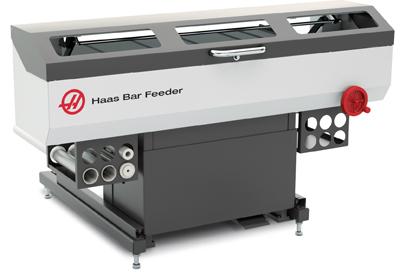
When Haas Automation introduced the Servo Bar 300 bar feeder in 1999, it was instantly popular, because it was compact, easy to use, and affordable. For 2015, Haas engineers went back to the drawing board to reportedly make bar feeder operations easier, more efficient and faster. The result is the all-new Haas Bar Feeder, which provides a simpler and more affordable way to automate part production on Haas turning centers.
It features a reengineered, heavy-duty – yet still compact – design that boosts productivity and streamlines turning operations.
Designed and built by Haas Automation exclusively for use on Haas ST-10 through ST-35 and DS series CNC turning centers, the Haas Bar Feeder connects directly to the Haas control, and is powered by the turning center.
Fast set up and quick changeovers are what sets the new Haas Bar Feeder apart from the competition. It features an innovative rollaway design that provides easy access to the rear of the lathe spindle for quick liner adapter and liner changes. Simply press the foot-pedal release, and the bar feeder easily rolls out of the way for access. When pulled back into position, the bar feeder locks into place completely, eliminating accidental bumps or alignment issues.
And making bar height adjustments is easier than ever, using a single handwheel right where it's needed to make visual "on-center" adjustments. Quick-change pushrods snap into place without tools, and both sizes store conveniently in the cover of the bar feeder. Built-in racks on both ends of the bar feeder provide storage for and easy access to all Haas extruded spindle liners, so there's no need to walk around the machine, as with the previous version.
To reduce cycle times, the Haas Bar Feeder uses a new belt-driven bar-shuttle system that is 7 times faster than the previous version, with lightning-fast retract speeds. Optical sensors accurately determine bar position, even on bars with chamfers and ragged ends, and stainless steel runners on the charging tray help bars roll down to the loading area much easier. Even square and hexagonal stock glide down smoothly to the new bar feeder tray.
Because it's integrated with the Haas control, all bar feeder parameters are set directly at the lathe. Easy-to-read, on-screen icons indicate if the bar feeder is out of position, has the lid open, or needs to be latched back into place.
Contact Details
Related Glossary Terms
- centers
centers
Cone-shaped pins that support a workpiece by one or two ends during machining. The centers fit into holes drilled in the workpiece ends. Centers that turn with the workpiece are called “live” centers; those that do not are called “dead” centers.
- computer numerical control ( CNC)
computer numerical control ( CNC)
Microprocessor-based controller dedicated to a machine tool that permits the creation or modification of parts. Programmed numerical control activates the machine’s servos and spindle drives and controls the various machining operations. See DNC, direct numerical control; NC, numerical control.
- lathe
lathe
Turning machine capable of sawing, milling, grinding, gear-cutting, drilling, reaming, boring, threading, facing, chamfering, grooving, knurling, spinning, parting, necking, taper-cutting, and cam- and eccentric-cutting, as well as step- and straight-turning. Comes in a variety of forms, ranging from manual to semiautomatic to fully automatic, with major types being engine lathes, turning and contouring lathes, turret lathes and numerical-control lathes. The engine lathe consists of a headstock and spindle, tailstock, bed, carriage (complete with apron) and cross slides. Features include gear- (speed) and feed-selector levers, toolpost, compound rest, lead screw and reversing lead screw, threading dial and rapid-traverse lever. Special lathe types include through-the-spindle, camshaft and crankshaft, brake drum and rotor, spinning and gun-barrel machines. Toolroom and bench lathes are used for precision work; the former for tool-and-die work and similar tasks, the latter for small workpieces (instruments, watches), normally without a power feed. Models are typically designated according to their “swing,” or the largest-diameter workpiece that can be rotated; bed length, or the distance between centers; and horsepower generated. See turning machine.
- turning
turning
Workpiece is held in a chuck, mounted on a face plate or secured between centers and rotated while a cutting tool, normally a single-point tool, is fed into it along its periphery or across its end or face. Takes the form of straight turning (cutting along the periphery of the workpiece); taper turning (creating a taper); step turning (turning different-size diameters on the same work); chamfering (beveling an edge or shoulder); facing (cutting on an end); turning threads (usually external but can be internal); roughing (high-volume metal removal); and finishing (final light cuts). Performed on lathes, turning centers, chucking machines, automatic screw machines and similar machines.
